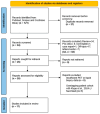Synergizing Liquid Biopsy and Hybrid PET Imaging for Prognostic Assessment in Prostate Cancer: A Focus Review
- PMID: 40723912
- PMCID: PMC12292956
- DOI: 10.3390/biom15071041
Synergizing Liquid Biopsy and Hybrid PET Imaging for Prognostic Assessment in Prostate Cancer: A Focus Review
Abstract
Positron emission tomography (PET) and liquid biopsy have independently transformed prostate cancer management. This review explores the complementary roles of PET imaging and liquid biopsy in prostate cancer, focusing on their combined diagnostic, monitoring, and prognostic potential. A systematic search of PubMed, Scopus, and Cochrane Library databases was conducted to identify human studies published in English up to January 2025. Seventeen studies met the inclusion criteria and were analyzed according to PRISMA guidelines. Across the included studies, PET-derived imaging metrics, such as metabolic activity and radiotracer uptake, correlated consistently with liquid biopsy biomarkers, including circulating tumor cells and cell-free DNA. Their joint application demonstrated added value in early detection, treatment monitoring, and outcome prediction, particularly in castration-resistant prostate cancer. Independent and synergistic prognostic value was noted for both modalities, including survival outcomes such as overall survival and progression-free survival. Combining PET imaging and liquid biopsy emerges as a promising, non-invasive strategy for improving prostate cancer diagnosis, monitoring, and therapeutic stratification. While preliminary findings are encouraging, large-scale prospective studies are essential to validate their integrated clinical utility.
Keywords: PET/CT; PET/MR; cancer biomarkers; cell free DNA; circulating tumor cells; imaging biomarkers; liquid biopsy; precision medicine; prostate cancer; translational oncology.
Conflict of interest statement
The authors declare no conflicts of interest.
Figures


References
-
- Siegel R.L., Miller K.D., Fuchs H.E., Jemal A. Cancer statistics, 2024. CA Cancer J. Clin. 2024;74:7–33. doi: 10.3322/caac.21820. - DOI
-
- Sekhoacha M., Smith A., Johnson P. Advances in molecular imaging and biomarkers for prostate cancer: A review. J. Mol. Diagn. 2023;25:234–247. doi: 10.1016/j.jmoldx.2023.01.005. - DOI
-
- Hofman M.S., Lawrentschuk N., Francis R.J., Tang C., Vela I., Thomas P., Rutherford N., Martin J.M., Frydenberg M., Shakher R., et al. Prostate-specific membrane antigen PET-CT in patients with high-risk pros-tate cancer before curative-intent surgery or radiotherapy (proPSMA): A prospective, randomized, multicenter study. Lancet. 2020;395:1208–1216. doi: 10.1016/S0140-6736(20)30314-7. - DOI - PubMed
-
- Wyatt A.W., Azad A.A., Volik S.V., Annala M., Beja K., McConeghy B., Haegert A., Warner E.W., Mo F., Brahmbhatt S., et al. Genomic alterations in cell-free DNA and enzalutamide resistance in castration-resistant prostate cancer. JAMA Oncol. 2016;2:1598–1606. doi: 10.1001/jamaoncol.2016.0494. - DOI - PMC - PubMed
Publication types
MeSH terms
Substances
LinkOut - more resources
Full Text Sources
Medical
Miscellaneous

